Main Test – May 2016 – Aurora A-Stralis
New Zealand Trucking headed to the bottom of the country where the Aurora Australis is sometimes seen, and Hobbs & Banks Iveco Stralis is occasionally visible too.

It was before dawn on a wet morning when we arrived in Edendale to rendezvous with Deane Harris and the Iveco Stralis livestock unit he drives for Hobbs & Banks of Geraldine. Deane had come south the day before and after dropping a load of sheep had prepped the 4-deck sheep/2deck cattle crates for a load of calves to be picked up at Slope Point, 70km east of Invercargill and the southernmost point of the South Island.
The Stralis has been on the road for 10 months and had 75,000km on the clock, but there were no squeaks or rattles from the truck or the Valley Crates 5-axle trailer as we made our way through the coastal settlement of Fortrose along the narrow roads heading towards the Catlins.
The Iveco‘s headlamps aren‘t brilliant, but proved more than adequate for cutting through the intermittent rain. Deane had been to the farm before, although the stock was to be picked up from a different loading ramp from the one previously used, nevertheless, the farmer‘s instructions are spot on and we arrived at 7:20am to find the calves waiting. The loading ramp entrance is on the main tourist route and although there‘s not a lot of room to spare, Deane had no problem getting the 23-metre-long unit into position. The sliding drawbar was activated from the cab and the walk-through crates quickly set up for the 170kg calves to be loaded 10 to a pen. Deane said he gives the stock plenty of room, because it is about 470km to their new home and they‘ll be in the crate for over seven hours.
He is an ex-farmer who still has a 40-acre block with his own sheep and cattle and clearly understands stock. He said the farmer has done a good job getting the calves ready for the trip and if they had been on grass they would soon have uncomfortable stomachs and many would lie down. The straw they have eaten will allow them have a comfortable journey. Less than an hour later we hit the road heading through the Catlins to rejoin SH1 at Balclutha. The unit is about six tonne below the 50 tonne it can run at, but even so the steep hills provide a good workout for the truck. What‘s more, the road is narrow and a popular tourist route. The farmer explained to us what it means to farm on a tourist route – he keeps his post rammer mounted to the tractor because he has to replace one or two fence posts most weeks due to rental cars running off the road.
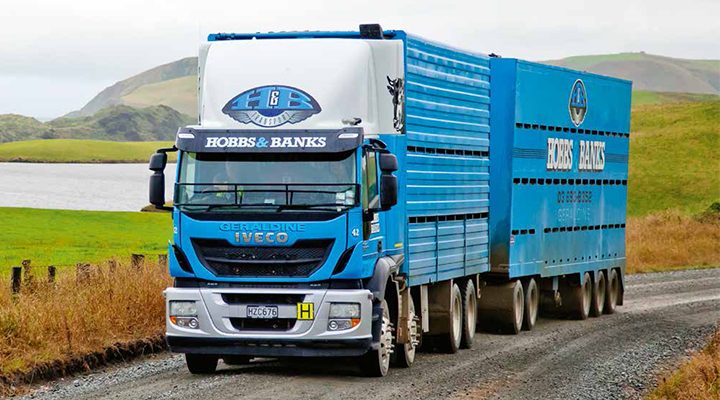
Hobbs & Banks Iveco Stralis is at home on the metal roads of the South Island.

Deane‘s obviously aware of the extra responsibilities a live load and the tourist road demands; on a short straight we slowed to let a campervan past, but when the tourists noticed the dog‘s head poking out of his box they slowed to take photos. A couple of kilometres further on the camper was parked and the occupants ready with their cameras to get a shot of the dog, Deane said it‘s a regular thing. The Iveco‘s 500hp is more than adequate for the route and the truck had to be slowed regularly for corners. Deane‘s smooth driving is excellent, but he gives a lot of credit for the smoothness to the truck and trailer. There‘s no doubt that the Iveco handles well and the European cabover is smoother than most trucks we ride in.

Part of the smooth ride is due to the airbags on the front axles; they supplement two-leaf parabolic springs and the unusual front suspension set may well deliver the best of both air and steel suspension. Iveco New Zealand sales consultant Straun Syme says the suspension system has been fitted to Ivecos since 1996. He said it reduces second axle ‘kick‘ and improves the steering lock, resulting in one of the best turning circles available on 8-wheelers. Disc brakes on the front axles of the truck and all the trailer axles ensure smooth deceleration under braking. The Iveco has a two-stage engine brake, supplying 50% or 100% retardation.
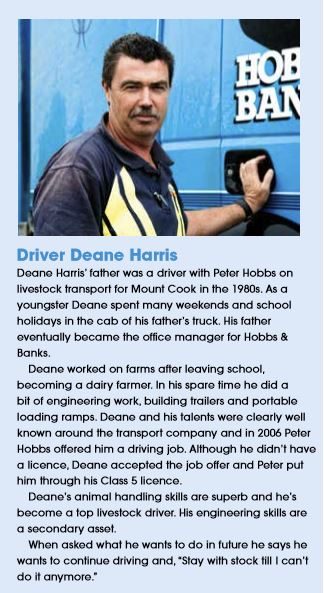

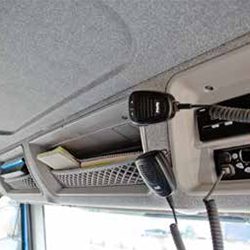
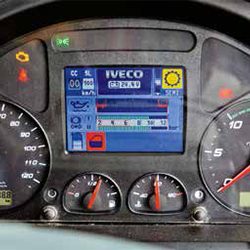
Left: Forward or reverse is selected via simple dash mounted push buttons.
Middle: There is plenty of practical in-cab storage, including overhead storage.
Right: The dash is easily read, and the digital display is comprehensive.
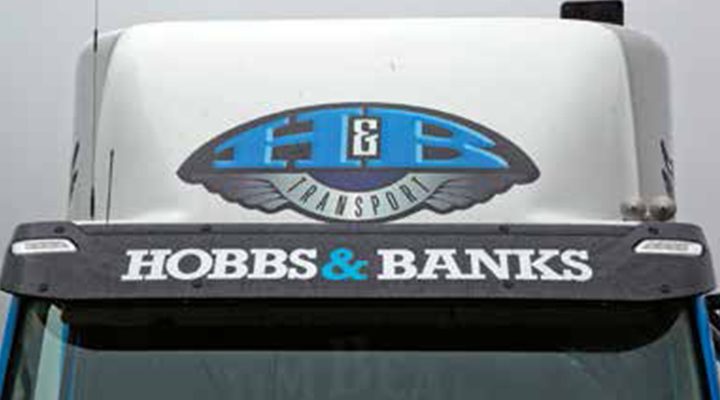
Hobbs & Banks is one of New Zealand‘s top five Iveco operators.
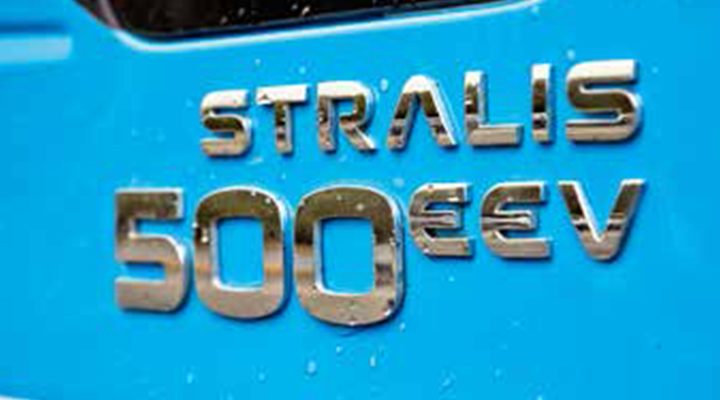
Power, efficiency and low emissions feature in the 12.9 litre Cursor engine.
Although one or two more stages would provide more options, the 16-speed ZF Eurotronic automated manual transmission (AMT) complements the engine brake superbly by dropping gears and holding a set speed until the accelerator pedal is touched. All the way through the tight turns and steep gradients encountered in the Catlins, Deane leaves the Eurotronic in full auto and never reverts to manual. He said there‘s no advantage and there doesn‘t seem to be any argument against his decision. There were a couple of times when the transmission changed down fractionally before the peak of a hill and it may have been better to hold it in the higher gear, but that‘s being picky. It‘s a similar transmission to the unit in the Hino we tested last month and we reckon the ZF 16-speed is a nice transmission.
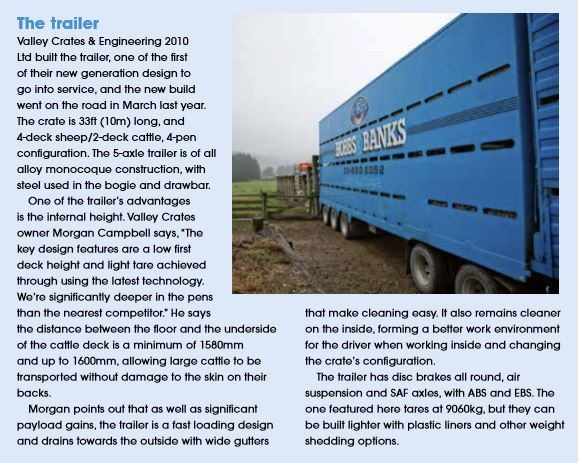
The changes are very smooth, hardly noticeable above fourth gear, and the transmission‘s ability to effectively skip gears when up and down shifting is excellent. It‘s probably an ideal transmission for livestock simply because it‘s so smooth. On the steep hills the transmission drops to 9th gear, but the truck handles most slopes comfortably in 11th. It changes up at between 1500 and 1700rpm and down at 1000 to 1200rpm; it clearly takes into account a number of factors and never makes a poor change. The route through the Catlins is sealed, but it‘s generally narrow and there is no margin for error if a tyre goes beyond the fog line. The trailer tracks particularly well.
Deane said when he first got the 5-axle trailer he was concerned about its ability to follow the truck, especially through gateways. But his concerns have proven unfounded; it‘s particularly stable and it backs well too. When we reached the Tahakopa River, the bridge was closed for strengthening and we had to take a 19km detour on a metal road up one side of the river, across a bridge and down the other side. The road camber was steep and the trailer didn‘t follow as well as it does on seal, but there are no issues and it‘s amazing how little influence the trailer has on cab comfort. On the outskirts of Balcultha Deane pulled the truck over in front of the saleyards to check the stock, take a break and give the dog a run.
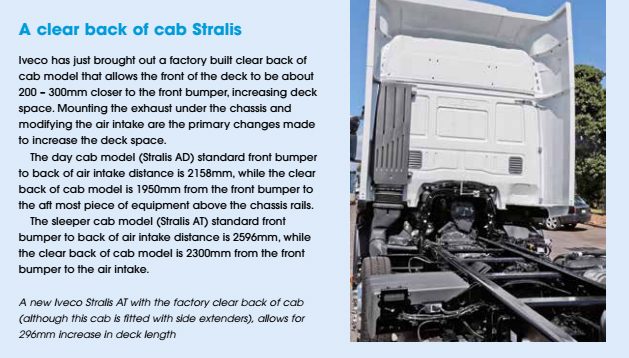
The stock are all comfortable and standing and the truck is now back in familiar territory, Deane doesn‘t get into the deep south that often, although the truck covers the entire South Island and has been as far north as Hawke‘s Bay. The stop provided an opportunity to have a good look at the truck. It‘s a day cab with a low roof, although a roof kit towers above the cab and long side extenders hide the big SCR exhaust and air intake behind the cab. Inside the cab there‘s plenty of room; the engine cover is well below knee height and has a large flat surface, ideal for Deane‘s chilly bin, and there‘s enough room behind the seats for a bag. Visibility is excellent and the climb into the cab is easy with big, well placed nonskid steps.
A nice touch in the cab is the sunshade on the window of each door. Plenty of storage is available. The driver‘s air seat is comfortable with plenty of legroom. The gear control is a push-button set on the dash, so there is no lever to intrude into leg space. The dash is uncomplicated, with a mixture of gauges – way less than a North American dash. The digital screen is comprehensive, but not large.
The trip up SH1 was easy for the Stralis and it rolled along in top gear most of the way. At a touch under 1500rpm in top gear the truck gets along at 90kph. It is equipped with cruise control, but Deane chooses not to use it. On the climb up Saddle Hill into Dunedin we drop down to 9th, but the 13-litre engine is torquey and puts out a surprising 2300Nm (1696lb/ft) at only 1000rpm.
With this amount of torque the gearbox starts changing up very quickly, long before we reach the top, and we crest the hill in 13th. The torque curve is flat between 1000 and 1500rpm and this is the key to the performance of the relatively low (for a 50MAX unit) horsepower engine. We came down the hill into Dunedin from Lookout Point in heavy rain and reasonably heavy traffic, but Deane used the engine brake effectively and comfortably in stage two and 10th gear at 2000rpm. Hauling up the Kilmog the gearbox did drop to 10th for a short section, but mostly handled the climb in 11th.
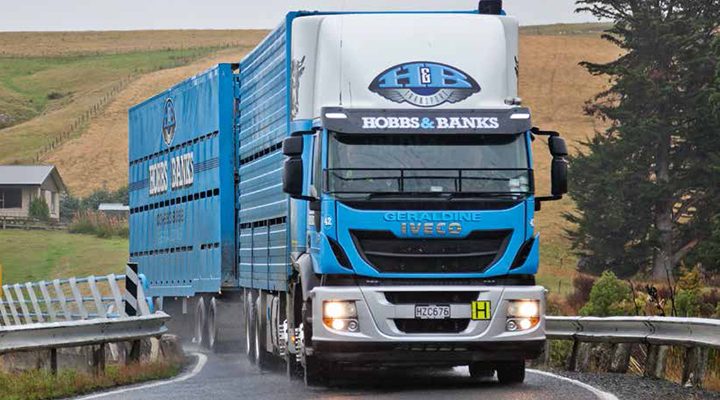
The Stralis handled the wet trip through the Catlins effortlessly.
Deane noticed the holding tanks were overflowing; he had emptied them before we started but the rain made a big difference. He pulled in to the effluent dump before Palmerston and emptied about 180 litres from the three tanks. A little further on we fuelled up at an Allied pump. The fuel consumption is damn good – over the trip it averaged 1.84kpl, an excellent return for 44 tonne with a lot of hills and some metal road work. The diesel emission fluid (DEF) tank is a healthy 100 litres and only needs refilling every five or six days. Hobbs & Banks owner Peter Hobbs says the 500hp Stralis‘ in the fleet are averaging 1.9 to 2.0kpl diesel consumption. Although the Stralis is not an expensive truck by most standards, there is nothing cheap about the build quality and equipment. All the comforts of a European truck are clearly there and it‘s only the high-level safety features such as lane control sensors and adaptive cruise control that are missing.
Read more
The right man for the job
0 Comments29 Minutes
Legendary ambition
0 Comments36 Minutes
Hard Fought!
0 Comments40 Minutes





